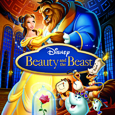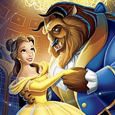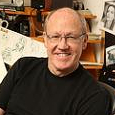Walt Disney Feature Animation (1991/2002), Walt Disney Home Entertainment (October 5 2010), 2 Blu-ray Discs plus 1 DVD, 92 mins plus supplements, 1080p high definition 1.78:1 widescreen, 7.1 DTS-HD Master Audio, Rated G, Retail: $39.99
Storyboard:
A young woman, Belle, takes her father’s place after he is captured by a monstrous Beast and held in a forgotten castle. With the help of his also enchanted staff, the Beast attempts to make life in the castle bearable for Belle, who comes to see his soft side. Over time, Belle and the Beast warm to each other, and the spell that has kept him hideously deformed looks like it may be broken, returning him to human form. But back in her village, Belle’s wannabe suitor Gaston becomes jealous and sets out to slay the Beast and take Belle as his own…
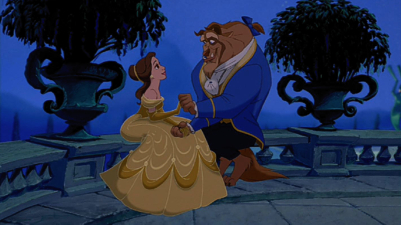
The Sweatbox Review:
It’s often been standard practice in the past to compare Disney’s Beauty And The Beast to Walt Disney’s Snow White And The Seven Dwarfs, by way of finding the similarities in story approach and tone and suggesting Beauty was the new generation of artists’ answer to the old generation’s first feature-length animated feature. And it’s hard to break those assumptions when Beauty became only the second fully animated film to be significantly recognised by the motion picture Academy (with the first animated nomination for Best Picture) after the achievement of Snow White was acknowledged by the famous full-sized and seven miniature statuettes honor presented to Walt by Shirley Temple.
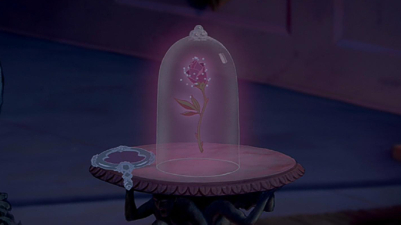
Even Frank Thomas and Ollie Johnston, two of Walt’s venerable Nine Old Men, amusingly admitted something along the lines of Beauty being “almost as good as what we used to do” after seeing the film. But, for me, it was The Little Mermaid that ultimately proves to be the new generation’s Snow White, the film where the artists set out to prove and push themselves, learning by mistakes, adapting technology for their needs, and creating a true fairytale classic that could stand with the best of them. The film after Beauty, Aladdin would become their knockabout comedy counterpart to Dumbo, while The Lion King’s circle of life obviously owes much to Bambi’s naturalistic take, and you don’t need to look far to find the equivalent to Fantasia!

So what would that actually make Beauty And The Beast, then? Well I think it has to be Pinocchio, still perhaps the most revered animated film to be produced in the pre-digital age. That film built on Walt’s success with Snow White, while his artists ploughed everything they had learnt on that feature into Pinocchio. The film’s production was stopped to refine story points and characters, and new technological advances were made with the Multiplane Camera. It’s true that the film was eventually released to only middling reviews in 1940, but over time it has become recognised for its near-perfect animation performances, and is often seen as the epitome of the animated art form.
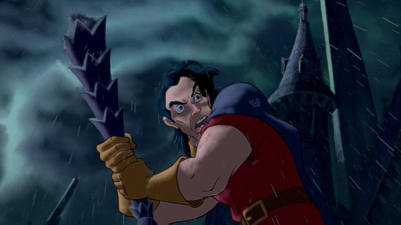
It’s a comparison that sits well with Beauty, a film that the new artists were able to create from building on what they had learned with Mermaid: the first version was scrapped, while new camera technology saw a move from traditionally ink and painted cells to Disney’s in-house Computer Animation (or Assisted) Production System, which scanned the artwork and stored it as high resolution digital files (itself a scientific Oscar winner for the developmental team at Disney Feature Animation and Pixar). The film was released to much more acclaim than Pinocchio had enjoyed first time out, but this was due in part to an unprecedented event that had occurred several months earlier, when a work in progress edition had been screened at the New York Film Festival, which created much word of mouth that Disney had topped Mermaid with a film that was really along the lines of what Walt would have crafted.
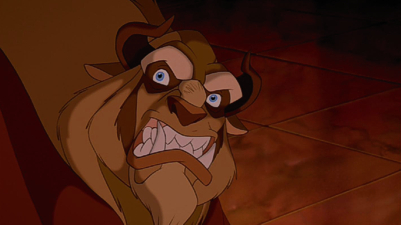
Of course, Walt himself tried to develop the Beauty And The Beast story, but it was either down to a lack of being able to nail the plot or a wariness of attempting another fairytale after the failure of the ambitious Sleeping Beauty that meant the project never came to fruition. Indeed, the finally released version differs from the original plot considerably: a more faithful version can be found in Jean Cocteau’s 1946 La Belle et la Bête, which first suggested objects in the Beast’s castle could be enchanted and that the Disney film takes to the next level in the characterizations of the Beast’s staff. They, like the Beast, have been placed under an enchantresses’ spell (though I’m not sure if it’s ever explained why they take on the forms they do)…a spell that can only be broken, as in all the good fairytales, by love’s true kiss.

It’s certainly a tale as old as time, but the handling is just superb, bringing back the Broadway talents of Howard Ashman and Alan Menken to provide an intricately interweaved song score that’s leaps and bounds ahead of what would have been found in animated films of the past. Indeed, such was the success of the film and the music that, when one critic suggested the then in-decline shows on the Great White Way wouldn’t be floundering if they had half the wit and charm of Beauty’s score, Disney was quick to capitalize in converting the film to the stage, pioneering the current concept of “moviecals” that now dominate New York’s theater district and London’s West End theaters.
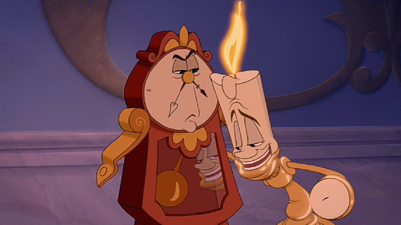
As for the film itself, it’s now become such a classic that it doesn’t even need the word “contemporary” before it. That it was such a hit at the time is down to the mature storytelling, from before when Disney sidekicks were just shoehorned in to please the kids, and an elevated level of filmmaking (the producing/directing team of Kirk Wise, Gary Trousdale and Don Hahn would progress even further with The Hunchback Of Notre Dame, surely the most elaborately produced Disney feature even if the signing gargoyles remove some of the prestige). Now almost 20 years old, there surely can’t be that many people who have not been entranced by its magic, either on the big screen or television by way of VHS, LaserDisc and DVD.
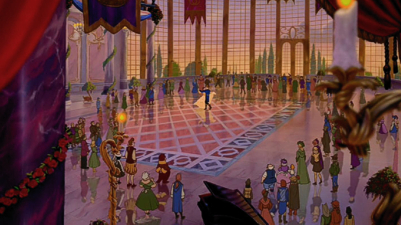
With its anniversary on the horizon in the form of an ultimately unneeded 3D theatrical makeover, Disney stands to potentially over egg what has become a franchise staple for them, after the original release, stage production and special edition Imax reissue with extra footage. So it’s quite fitting that, before that, we can get a chance to see it as originally created, in the best possible presentation of the film for the home market. A highly anticipated release, the important aspect of this review will be what that presentation is actually like, alongside the supplements that have been added – or subtracted – from previous editions. There’s plenty to explore, but at the heart of this set is a film that comes fully recommended for certainly being genuinely as good as the Disney classics of old.
Is This Thing Loaded?
In a word…yes! For its second Diamond Edition title, Disney has pulled out the stops to fill the two Blu-ray discs included, and the overall feeling, while not porting absolutely everything over, is that the package is certainly more Beauty than Beast!
First things first on Blu-ray Disc One, and the main menu could quite possibly drive you insane with how great it is. Hosted by Lumiere (whoever it is, it’s a terrific sound-alike for the late Jerry Orbach), this is quite staggering at how exhaustive the set is going to be, with options for customising the menus from screensaver choices to how you navigate the disc all presented with instrumental music from the score as the menu wanders around a CG representation of the castle. Getting the usual Sneak Peeks out of the way, they now following the new Disney trend of playing in a long loop as opposed to being optionally selectable. Actual title previews, amongst other spots and promos, include The Lion King, Fantasia/Fantasia 2000, Alice In Wonderland: 60th, A Christmas Carol, the full trailer for Tangled, the upcoming Bambi Diamond Edition, Toy Story 3 and, finally, the long-awaited Dumbo: 70th Anniversary Edition.

As with the Platinum Edition DVD of before, this new Diamond Edition offers up three versions of Beauty And The Beast – or just about: you can read much further on the merits of these in the Ink & Paint comments below. Included are the Original Theatrical Edition, a picture-in-picture Storyreel version, and the re-tooled Special Extended Edition, for which a commentary (from the Platinum disc) has been carried over, though it’ll take you an age to find it if you don’t know it’s in the Modes section of the menu. The track, featuring Hahn, Wise, Trousdale and an inserted-in Menken, remains a terrific such commentary, with a lively discussion taking on board all the things one might wish to know about, including the thoughts behind the Imax edition and how many of the film’s scenes were achieved. It would have been great to have been able to run this against the workprint, but it only accompanies the extended cut and, with the workprint reduced to a stupidly small area of the image, it’s not ultimately worth watching, apart from seeing some of the original original cut backgrounds.
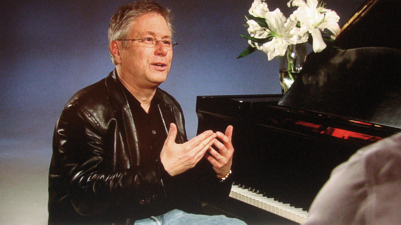
Other than a sing-along subtitle track, that’s it for extras that play through the movie, so we move on to Backstage Disney, which collects two extras (all in HD except where noted). Composing A Classic is a twenty minute conversation featuring Menken, Hahn and Disney historian/music supremo (and Menken’s agent) Richard Kraft as they discuss the songs and score for the film, with particular emphasis on Menken and Ashman’s partnership and their approach to the music. The opening text makes it sound like we’re going to witness some very early pre-production footage, but it’s just a fancy way to dress up the “rare” meeting for this release. It doesn’t matter, as this turns out to be very special anyway, especially as Menken often runs his fingers over the piano keys to revisit the songs, including the genesis of a different take on Be Our Guest. Pure magic, even if the funky camerawork can’t keep still or in focus.
Two Deleted Scenes moments are selectable next, both available with or without introductions. An Alternate Story Opening runs a lengthy 18 minutes including an intro from then-Disney president Peter Schneider, this is a completely different take on the material from very early in the production, following an even more classic Disney approach that recalls the European flavor of Cinderella especially. Centered much more on the original story, in which Belle’s father attempts to claim a rose for his daughter, this elaborately drawn storyboard has been dressed up with final score from the eventual film result, which makes it very entertaining, and even if it’s clearly a bit rushed, one must wonder at what might have been, since it does feel rather epic in tone.
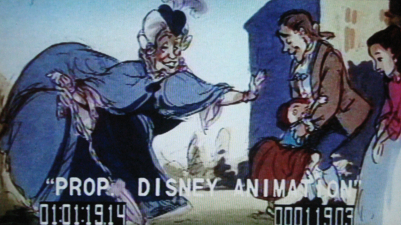
Belle In The Library plays for nine minutes with an Introduction by Roger Allers (or not if he isn’t selected, though there’s no Play All option for running these clips together). This is apparently from the eventual version of the movie, though cut part way into production, so it’s all storyboards in this overlong scene that, while it’s cute to meet four additional enchanted castle characters, is clear as to why it was trimmed, especially since the insertion of the Human Again sequence. Heading into something called Family Play proves to hold at least one decent extra, a fluffy but interesting overview of the Broadway production of Beauty And The Beast, a thirteen minute piece titled Broadway Beginnings, that speaks to those who have starred in the show over the years, and stays away (for the most part) from outright promotion.
Of less interest is a new music video of the title song, dropping the Jump 5 popped-up version from the previous DVD for a three minute HD helping featuring Jordin Sparks. It reeks of just being there for the sake of being there, and is nothing special, certainly not as fun as Jump 5’s edition, which at least was bouncy. Here, Sparks is placed in a series of castle locales, but that’s about as interesting as it gets, and the next “extra” isn’t really even worth a mention, being one of those “take your movies on the run” spots that only plays up the fact that this set is missing that particular ingredient!
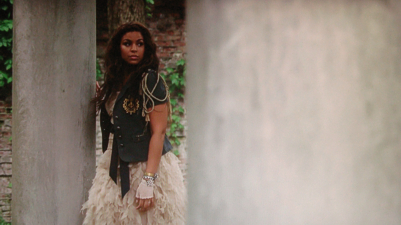
Following on to Blu-ray Disc Two, we find the majority of the supplements, which are redundantly referenced from both discs in what is basically the same menu shared by both platters. The significant supplement on Disc Two is the new extensive documentary Beyond Beauty: The Untold Stories Behind The Making Of Beauty And The Beast. I say “extensive”, since selecting the many additional featurette points that pop up throughout this six-part feature can ultimately expand the full viewing time to almost four hours! This is as in-depth as things get, and you can truly expect to sit down for an entire evening to plough through the sheer amount of material on offer, from a brief discussion on where Disney Animation was as Michael Eisner, Frank Wells and Jeffrey Katzenberg entered the management suites, to the release of the film, the reaction and continuing success as a Broadway and Imax re-release.
What’s neat is that whenever you divert off into a section to learn more about a particular aspect, you’ll seamlessly return to the exact point in the documentary you left at, which introduces a very fluid way to explore the extras. If there’s a featurette you’d like to directly access, a menu within Beyond Beauty allows one to select individual clips, although there’s no way to skip around the actual documentary: once strapped in, you’re there for the long run. The additional featurettes pick up on cues from the main program, so some talk – from any number of Disney associated names (pick anyone, and they’re probably here) – on fairytales, for instance, leads us off on a look at Disney’s earliest examples, with four selected Laugh-O-Gram shorts (Puss In Boots, Little Red Riding Hood, Cinderella and The Four Musicians Of Bremen).

It’s a similar approach to the tour of the Hyperion Disney Studio found in the Snow White set from last year, although this time, because the emphasis is so closely focused on Beauty And The Beast as a center, these flights of fancy actually feel like suitable additions and foot notes, rather than a collection of cool material that ultimately meant the loss of more important footage on the Snow White set. Act II: Struggling With The Beast looks at early development, from (actually redundantly) repeating the Alternate Opening to looking at Ashman’s impact on coming to Disney, while Act III: Something There expands on those themes, with a tribute to Ashman and further Deleted Scenes: the previously seen Maurice version of Be Our Guest, another repeat for Belle In The Library from Disc One, and the original, pre-Imax storyboard tryout for Human Again.

Act IV: Casting A Spell delves into the actual animation production, explaining how the new generation of artists were intentionally attempting to capture the spirit of Walt’s classics in their new films, with additional Galleries highlighting Character Design, and a Video Gallery offering the animators a chance to speak about how they approached certain characters. There’s also an offshoot link to a brief look at the CAPS work, a discussion with the vocalists for the two title characters (and the fun banter/interplay between two of the character animators), and a further two Disney cartoons: The China Shop and Music Land, as well as an excerpt from Alice In Wonderland, all here employed to describe how they were referenced by the animators while they attempted to bring inanimate objects to life and give them personality and visual characteristics.
Act V: A Fairytale Ending includes, among its overview of the film’s workprint preview, final release and Oscar recognition, there’s a “Thumbnail Sketch Of The History Of Animation”, a 14-minute potted look back over decades of cartoon film, along with further Stills Galleries that offer a look at Visual Development and Backgrounds. Finally, Act VI: Classic Beauty rounds the main documentary up with some closing comments, after a marathon but totally enthralling four hours or so (including breaks!), which could stretch much longer if one were to really examine all the galleries in their full depth. I can’t wait to go back and explore this more fully, especially as I wasn’t able to view all the clips, though with several more features yet to come, let’s press on for now…
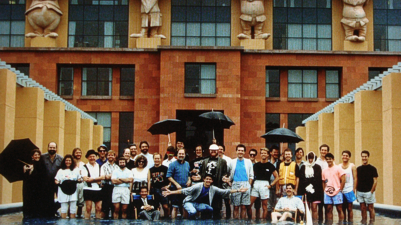
This disc’s Family Play section is where the games are to be found, the first of which is the Enchanted Musical Challenge: A Disney Quest Game, which has nothing to do with the Disney Quest brand (or Enchanted, for that matter). Here, the player – or four – must group together a bunch of objects and characters by searching around the menu’s CG castle, so that Belle and the Beast can fall in love and he can become human again. It’s rather complicated, if quite impressively rendered as many of these BD games are, and those that find such things fun will find a good few levels here to engage you. A further option is the Bonjour, Who Is This? game, playable via the internet connected BD-Live network, though since some of the featurette offshoots from the Beyond Beauty documentary wouldn’t play in my regular player I had to review this disc on a deck that wasn’t web-enabled. From the sounds of it, however, it seems like a real chore to set up in order to play, and since these results are rarely worthwhile, I’ll leave it up to you to bother with it!
A welcome porting over from the previous Platinum Edition – though only in standard definition – are the Classic DVD Bonus Features (I still can’t quite see the term classic being the right one applied to something less than ten years old, but I guess “Vintage” would be seen as being too “old” by marketing). Since these are basically older features, there’s no need to spend too much time commenting on them here, though if you haven’t seen them before, there’s a lot to explore here, too. The Story Behind The Story, hosted by Celine Dion isn’t really Beauty-focused, but delves behind the stories of several other Disney classics, while Dion turns up again in the original music video for the Beauty And The Beast single.

Some further developmental footage is offered next, with the Early Presentation Reel, an alternate intro to the Maurice version of Be Our Guest, and an alternate scoring of the Beast’s Transformation scene, using a gorgeously orchestrated and much more sombre score from Menken. The original version of Human Again, from before it was cut out and then added in again for the reissue, is shown again in concept form, with different and separate introductions from Hahn and Menken, and there are more development material with Animation Tests, The Transformation: Pencil Version, Glen Keane speaking about his approach to the scene, and a Camera Move Test, which reveals the then groundbreaking computer work in the ballroom scene. Finally, a gallery of Trailers and TV Spots finishes things up, including the original and Imax reissue previews.
WHAT’S MISSING?
Well, it’s a shame that some of the standard definition material repeats what we’ve seen throughout the Beyond Beauty documentary, since there’s some valid stuff from the Platinum Edition that hasn’t made the cut. I’ve mentioned the Jump 5 music video, which isn’t a great loss but would have been fun, as was the Disney Animation Magic featurette, and though I don’t feel any great sadness at missing a couple of set-top games, there were additional picture galleries (some with enhanced audio commentary) that covered other aspects of the film’s release, particularly its publicity, which feels lacking here. The time of release also heralded the David (Cogsworth) Ogden Stiers hosted TV special The Making Of Beauty And The Beast, available on the CAV LaserDisc but not yet carried over to DVD or Blu-ray. That’s a great shame and would have been much more welcome than those repeated segments.
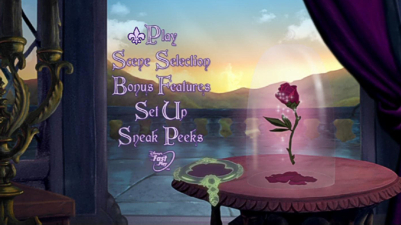
On the standard definition DVD the features are much much easier to sum up, especially seeing as there’s so little on the disc! Okay, there are a number of Sneak Peeks, the extended edition audio commentary and the sing-along track option for the movie itself, available in all three flavors, including the Work In Progress edition. However, although this time the workprint does play fullframe, the disc follows the Platinum effort of before, substituting shots out for finished scenes from the alternate version of the film included. Thus, the theatrical and Imax reissue cuts are included, though with all the amount of material on offer, not one of them looks particularly clean of macro blocking, and the color, although improved from the Platinum, isn’t as well defined as on the BD, looking quite over saturated in parts. For those seeking to skip Blu-ray, choosing the 2 Disc Edition coming in November is probably advised instead, though it waits to be seen if that disc will be worth purchasing again over the original Platinum Edition.
Case Study:
Going for the usual approach that has seen Belle and the Beast dancing in the ballroom surrounded by the supporting cast on everything from tape and album sleeves to previous home video releases, the Blu-ray cover art doesn’t really bring anything new to the party. But it looks nice enough, and the embossed glossy feel adds a bit of magic , but be aware that, like Snow White, the set comes in two versions: a standard Blu-ray sized case (which is the one you want if you want it to match your other Disney BDs) and a totally redundant DVD-sized version, which can only have been put out there to fool those into thinking they’re picking up the DVD edition not available until next month.
Those without a BD player wanting to explore the bonus features will have to wait for that set…or immediately go and be forced to upgrade, which I presume the point of the package is, because only the first disc from the 2-Disc DVD set is included. Those with Blu-ray need not worry so much: the choice will be down to how fussy you are over lining up your other discs, though I will say the DVD case we got sent will looks crummy standing in with my other Disney discs. A worrying note on the back reads: “This film has been modified to fit your TV”, which is confusing and makes little sense as one would have thought it doesn’t apply here.
The usual inserts include the Disney Movie Rewards code, plugs for Blu-ray, and a Blu-ray Guide that announces Bambi and The Lion King as the next releases in the Diamond Edition collection.
Ink And Paint:
The way Beauty And The Beast has been presented over the years has always been a matter for huge debate. Created at a 1.66:1 ratio, the original theatrical presentation would have cropped the top and bottom for a 1.85:1 frame. On VHS, the 1.33 frame cropped on the sides, but added some info top and bottom. LaserDisc provided the best source, offering a letterboxed 1.66 ratio as intended, along with a suitable color palette. Released to Imax screens, huge portions of the movie were reanimated to take the magnified image into account, with the Human Again sequence, featuring the cast cleaning up the castle, meaning that the second half of the film’s backgrounds had to be changed from dirty to clean.

When the film debuted on DVD, the return to 1.85:1 framing was obviously too tight, suggesting that a less-than 1.66 width had been used as a basis (the same, incidentally, that has happened with Mary Poppins on DVD). Worse still, the colors appeared washed out, or at least brightened up beyond the original version, looking more like a Disney direct-to-video title than an Oscar-nominated theatrical feature. That disc also offered the three different editions of the movie, but space demanded that, post the Human Again sequence, the rest of the movie, either in theatrical or special edition form, basically played the cleaned up version.
Thankfully, we get a bit of a hybrid here that at least more closely echoes the theatrical cut, even if the branching offers a hideous cut between the end of Something There and the Beast being washed for his night with Belle, meaning that the original Original Theatrical Cut is now a thing of memory, unless you are lucky enough to have retained a CAV LaserDisc edition! But now, instead of the cleaned up castle, the film does revert to how things looks originally, even if there are a few other tweaks, though the original end credit scroll has been inserted, with a bit of aged gateweave, as opposed to the “flat” credits. It’s still not, ultimately, a huge deal, but it’s not the Original Theatrical Edition, with all its non-reanimated Imaxed fixes and tweaks, either. So it seems the Imax Special Edition is to be the default option for the film from now on, which is backed up as being the automatically chosen option when the disc spins.
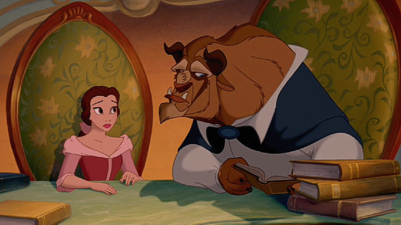
If you can live with that, then you’ll be pleased to know that at least the film looks marvellous, and brings the colors back down to a more acceptable level after the DVD washout. The colors are still more vibrant than I remember them on theatrical or Laser release, but overall the image is more contrasted and fitting for the often sombre tone of the film. There’s certainly more image information, too, presenting a 1.78:1 ratio that adds quite a bit around all four corners: I’d wager that, finally, we’re seeing the original 1.66 width again, with a little cropping top and bottom to fill the hi-def frame, which makes it less tight than before. Further changes to the Theatrical and Imax cuts include additional animation tweaks – most likely being added in from the upcoming 3D version – and the replacement of the blue Disney castle to the new Wonderful World Of Disney styled update along with the Steamboat Willie animation logo.
When it comes to the Work In Progress version previewed at the New York Film Festival, it’s frustratingly a different matter again! Presented as an unfinished film, the Studio wanted to start positive word of mouth, knowing that they had a quality film and were excited to share it. Much more of the film was finished than was shown, but Disney didn’t want to spill all of its magic too early, and the cut shown was actually an earlier version, completed in so far as sound, but presented as a combination of mostly concept, storyboard and pencil animation as well as only a several completed scenes. The film worked its magic, and a LaserDisc edition of that workprint was released, which those fans lucky enough to have snapped up will also want to retain.

Although this “Work In Progress” edition was also included on the previous DVD, it was actually a bizarrely reworked cut that again took its cue from the Imax special edition and filled in more of the finished animation by branching off into the completed film files, to save on disc space (after all, three versions of a feature is a lot to stuff on a DVD). Now referred to as an Original Storyboard Version, this edition differs again by offering what seems to be the original workprint of before, though most frustratingly, it isn’t presented fullframe, instead appearing boxed in a picture-in-picture overlay, much like the recent Princess And The Frog, making it harder to see the otherwise very interesting work that went into the film during its production. I guess space is a consideration again even with Blu-ray, but suggesting we can view “three versions of the film” when really it’s just the Imax edition with call-backs to the other two, isn’t being particularly clear or honest about what’s included.
Ultimately, Beauty And The Beast looks great – apart from one or two shots where Mrs Potts’ rouge look like clown painted spots – and if you’re happy with forgoing the Original Theatrical Version as you originally saw it, and okay with not being able to really engage with the Work In Progress/Storyboard edition since it’s so small in the screen area (as opposed to the better quarter screen look we see in Don Hahn’s intro, though it’s still nice to see the more muted, earthy color tones), then this hi-def debut for one of Disney’s best films, basically in its Imax special edition format with some new tweaks, should satisfy.
Scratch Tracks:
Happily, Beauty’s sound is an area that provokes much less criticism, even if the previous DVD did delete a line of dialogue from the Beast that was among one of the reasons that I loved the movie. A stutter from Robbie Benson’s recordings was left intact in the final animation, and it was this attention to rounding out a character that made Beauty something special. Who would intentionally leave a stutter in an animated film? Wow, I thought…that’s a really good pairing of vocal and animation performance. Except that someone at Disney thought it was a mistake, and deleted the portion of audio from the previous DVD – but hurrah!…it’s been reinstated here, so all is once again well in the world.
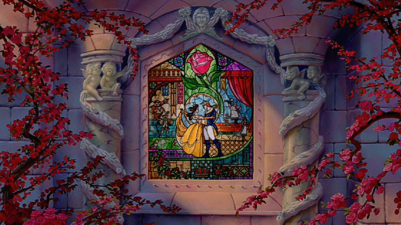
The rest of the soundtrack literally sings, too: a quite brilliant 7.1 DTS-HD Master Audio mix really gives your system a workout, with sound coming from all directions and a lovely atmosphere to the locations that I’ve not really noticed before. I should point out that the included DVD sounds pretty good, too, in a Disney-Enhanced 5.1 track, though it sounds much better than it looks: with three editions of the movie included, compression is tight, and although the coloring and framing is much preferable over the previous DVD, the sharpness fails this transfer, which looks soft and compressed in comparison.
In addition to the English tracks, French and Spanish subs and dubs are included in various forms across the two formats.
Final Cut:
It’s almost a given that Beauty And The Beast in high definition be automatically recommended, but as with Snow White last year, that recommendation is given with a few caveats. Picture and sound are great, bearing in mind the alterations the film has been given since original release, and the extras provide a generous look into the film’s production, even if they can be a chore to reach and enjoy. But overall this gets so much more right than so many other recent Disney sets have got wrong, and as the only way to see the film in hi-def, there really isn’t much other choice. As such, it’s pleasing to report that Beauty And The Beast has got the kind of treatment it deserves, and though the set may not be all-encompassing, it’s nonetheless a very fine addition to the Diamond Edition series which raises the bar immensely high for further titles to follow.
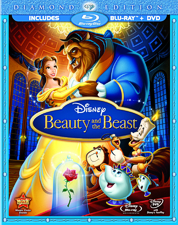 | ||
 |


